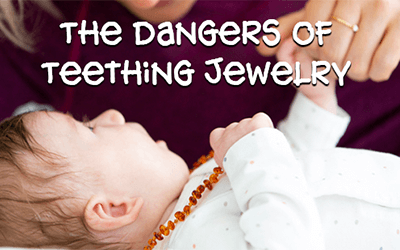In recent years, the trend of using special necklaces, bracelets, and other jewelry designed for chewing has become a ready source of relief for parents of teething toddlers or those with special needs. The problem is that, recently, the FDA has warned that these items are not necessarily safe.
What the FDA Has to Say
In a December 2018 Public Safety release, the FDA warns parents and caregivers that much of what is being sold as “teething jewelry” may not be safe for young children or those with special needs who may be seeking a sensory stimulation aid. Often made from materials like amber, wood, marble, or silicone, these necklaces and bracelets are not made of the traditional and more durable hard plastic or rubber found in teething rings, and have been increasingly found to be a choking hazard, a strangulation hazard, or a source of injury and infection to the mouth and gums—even when used according to manufacturer’s suggested uses. This warning also extends to commercially available teething creams, gels, and sprays.
Why is Teething Jewelry Risky?
Citing a number of well-documented cases where choking or strangulation occurred as a direct result of using teething jewelry, the FDA points to the unique materials often used in these special pieces as a source of the risk. The suggestion is that these less-durable alternatives to the plastic and rubber found in traditional infant-teething devices can break down and break off in the user’s mouth. Similarly, the fastening systems and binding agents used can be an ill-fit for young wearers and, when coupled with the stress and strain of use, can cause a strangulation risk. Even if the item is used properly and does not break down, the risk of injury and infection remains high given the direct path that contaminants are given to the body through oral contact.
Proponents of these items (also often retail providers of the items) provide lots of counter-warning opinions—even going as far as to suggest that the Succinic acid (present in the Baltic amber used for these pieces) provides not only teething relief through manipulation but also an analgesic agent when absorbed through the mouth. This claim is entirely unsubstantiated by the FDA, and only addresses one of a number of manufacturing approaches for these items. The bottom line is that, whether through improper use or substandard manufacturing, these items can present a genuine risk to users. When alternative options exist, we just don’t see the point of taking such a risk.
Safe Solutions to Relieve Teething Pain
You’ll be pleased to hear that among all of the warnings associated with alleviating teething pain, we’re happy to share a number of things you can do to bring about the relief you’re seeking for your little one:
- Talk to your pediatric dentist about manual massage techniques for the gums and teeth to relieve pain from pressure and swelling
- Use teething rings or other approved teething items made of a firm rubber—just be sure that they are only used under caregiver supervision, and that the material is not frozen or too rigid (as this rigidity can cause oral injury).
- Use a cold, wet washcloth with gentle pressure to relieve local pain.
- Make regular scheduled appointments with a qualified pediatric dentist to be proactive with your oral health habits and prevent pain-causing conditions from developing.
For more information on this, view our post Teething Troubles: Easing the Pain and Worry.


